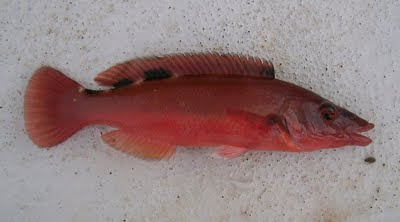 salting ragworm
salting ragworm
Getting bait can be a problem; often the times you want to fish do not coincide with the times the bait shops are open. It is useful to have standby baits if you can't get fresh, frozen mackerel, squid or sandeel is easily obtained and stored but worm baits present a problem. Because of their high water content normal freezing will result in breakdown of the cell structure of the worm as the ice crystals form and expand, leaving you with a mushy bait when it thaws. One of the oldest methods of food preservation is by salting, salt will remove the water from the worms, dry them out, and preserve them. The process is simple, put a half inch layer of salt in an old plastic container, add worms so that they don't touch, add more salt to cover them, add more worms and so on. The initial uptake of water from the worms is rapid and after a few hours the salt will have become very wet. Take the worms out, knock or brush the salt off the worms as best you can so that the next dry salt can reach the skin of the worms and not residual wet salt, repeat the salting with fresh salt in a dry container. Leave for a day or so, take the worms out, knock the salt off and repeat the process again. The salt can be dried out on a tray in a dry warm place and reused again and again, it will pick up a smell from the worms.... if that bothers you then salt is cheap in any case. After another day or two the worms will be dried out and have a tough texture; they can then be stored, in a fridge or not, I've left my salted worms in a tackle box in the car for days and in a cupboard for weeks or months with no deterioration in the fish catching ability of the bait.
A plastic colander can be useful for sieving out the worms and bits of vermiculite or peat that the worms were sold with at the shop, don't use metal, damp salt is highly corrosive.
 salted ragworm, after second day, ready to use or store
salted ragworm, after second day, ready to use or store
The salting process will shrink the worms, the two worms to the right of the coin were 6 to 8 inches long when they were alive. The worms are a tough hook bait and stay on the hook better than fresh worms, they will bulk up when they are in the sea as the water replaces that taken out by the salt.
I usually leave the worms in paper in the fridge until they are dead or dying... I'm sure the fish prefer the bait with a bit of smell to it, they certainly catch more than worms salted when still fresh.
 these were salted months ago
these were salted months ago
I find that the salted bait is taken readily by all species of fish, it is an especially good bait for match fishing in early spring when catching rockling and other small species can mean a match win. I prefer the preserved bait to fresh, the catch rate is noticeably higher. It is satisfying to beat your fellow anglers with bait they have given you after the last matches.... at the end of a match I've been given scores of worms..... " because they won't keep "..... oh yes they will !
I was asked by one chap if the taste of salt puts the fish off , I did point out to him, as gently as I could, that the fish are quite used to the taste of salt..........
 April sunshine, West Bay, Dorset
April sunshine, West Bay, Dorset













































